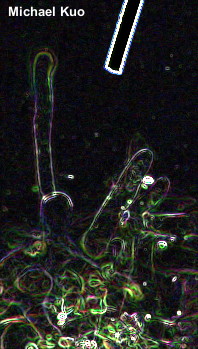| Major Groups > Boletes > Xerocomus illudens |

|
Xerocomus illudens [ Basidiomycota > Boletales > Boletaceae > Xerocomus . . . ] by Michael Kuo Xerocomus illudens is a hardwood-loving bolete from eastern North America, characterized by its relatively small size, the wide-meshed reticulum on the upper portion of its stem, the lack of any blue staining on its surfaces and flesh, and the blue-green reaction of its cap surface to ammonia. Its pore surface is yellow before it turns olive, and the pores themselves are large and angular. This description, however, applies pretty much equally to Xerocomus tenax, so the following features must be added in order to separate Xerocomus illudens: the cap is usually more red in Xerocomus illudens; the stem is usually more decidedly yellow than the stem of Xerocomus tenax, and less extensively reticulate; and, definitively, the terminal elements of the pileipellis are fatter and more frequently septate, creating a palisadoderm. Both Xerocomus ferrugineus and Xerocomus subtomentosus can appear similar. The former also turns green with ammonia—but grows under conifers, is usually a bit larger, and usually features a distinctively lined, rather than reticulate, stem. Xerocomus subtomentosus also grows under hardwoods, but turns red with ammonia and is usually a bit larger. Boletus illudens is a synonym. For a discussion of the genus name Xerocomus, see the page for Xerocomus subtomentosus. Thanks to Pandra Williams for collecting, documenting, and preserving Xerocomus illudens for study; her collection is deposited in The Herbarium of Michael Kuo. Description: Ecology: Mycorrhizal with oaks, hickories, and possibly with other hardwoods; growing alone, scattered, or gregariously; summer and fall; widely distributed in North America east of the Rocky Mountains. The illustrated and described collections are from Illinois, Indiana, and Georgia. Cap: 5–10 cm; convex, becoming broadly convex or nearly flat; dry; bald or, when young, very finely velvety; brownish red to reddish brown. Pore Surface: Yellow, becoming olive yellow to brownish yellow with maturity; not bruising, or bruising brownish (rarely bruising bluish); pores primarily angular, 1–2 mm wide; tubes xerocomoid, to 11 mm deep. Stem: 3–5 cm long; 0.5–1 cm thick; tapered downward; dry; solid and tough; widely and coarsely reticulate with a brownish to reddish reticulum near the apex (or sometimes for half—or more—of the stem's length); yellow to pale yellow; basal mycelium whitish to yellowish. Flesh: Pale yellow; not staining on exposure, or turning slightly pinkish in the stem. Odor and Taste: Not distinctive. Chemical Reactions: Ammonia flashing blue-green on cap, then resolving to blackish with a greenish ring; negative on flesh. KOH dull orange on cap, sometimes with a blackish ring; dull orange on flesh. Iron salts negative on cap; negative on flesh. Spore Print: Olive to olive brown. Microscopic Features: Spores 9–15 x 4–5 µm; long-fusiform; smooth; yellowish in KOH. Hymenial cystidia lageniform; golden in KOH; inconspicuous. Pileipellis a collapsing palisadoderm; golden to yellowish in KOH; elements 5–15 µm wide, smooth, frequently septate; subterminal cells often swollen and/or barrel-shaped; terminal cells very variable, ranging from short and clavate or pinched to elongated and cylindric, often thinner than subterminal cells. REFERENCES: (Peck, 1898) Singer, 1946. (Saccardo, 1899; Coker & Beers, 1943; Singer, 1945; Snell & Dick, 1970; Smith & Thiers, 1971; Smith, Smith & Weber, 1981; Phillips, 1991/2005; Both, 1993; Bessette, Roody & Bessette, 2000; Kuo, 2007; Binion et al., 2008; Kuo & Methven, 2014.) Herb. Kuo 10161302, 07141608, 07201608. This site contains no information about the edibility or toxicity of mushrooms. |
© MushroomExpert.Com |
|
Cite this page as: Kuo, M. (2016, August). Xerocomus illudens. Retrieved from the MushroomExpert.Com Web site: http://www.mushroomexpert.com/xerocomus_illudens.html |






